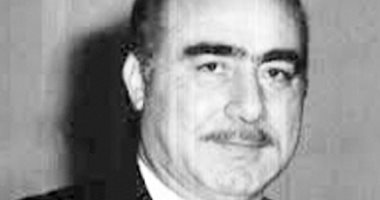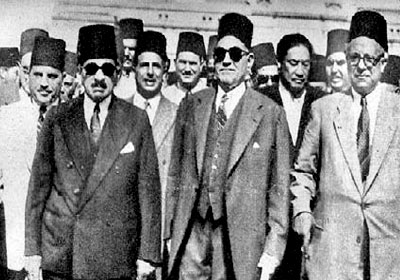|
|
The Paras in the Canal Zone
اقتباس:
Sgt Terry Lawton tells his storyIn June of this year I was invited by Doug Reeve, (their Secretary) to address members of the British Airborne Forces Association of Canada. Doug, who lives in Burlington Ontario, was in Egypt in 1951 with the Airborne Signals, 16th Independent Parachute Brigade Group.
While at this meeting I made the acquaintance of ex-Sgt. Terry Lawton of the 3rd Parachute Regiment, 16th Independent Parachute Brigade Group. He forwarded to me a copy of a chapter from the book "The Red Devils" by Major G.G. Norton. This chapter covers Egypt 1951 to 1954. Terry was a Sgt. with this group and what is stated that this book is right on.
The Brigade Group embarked on the aircraft carriers "Warrior" and "Triumph"(with all their heavy equipment) for Cyprus. The Parachute Battalions were then flown into Egypt with their equipment and Brigade H.Q. The transport and guns followed by sea. Tented camps were established in various lonely stretches of the desert, to await developments.
These developments were not long in coming and late in 1951
workers went on strike. The Paras took over the docks and 33 Para Lt. Regt. RA took over guard and general duties. In the Ord. Depot at Geneifa, 63 Company RASC, and from 1 Div, 4 Company RASC took over general transport duties. Towards the end of the year things began heating up. 1 Division, 3 Division, and 16 Para Brigade moved into the desert west of the Suez Canal. If British lives were put in jeopardy the 1st Battalion Paras were ready to launch an airborne assault on Cairo, in conjunction with an attack led by the 3rd Para (Terry's Regiment), and a squadron of the 4th Royal
Tanks.
The Egyptian Army advanced to within 5 miles of the Canal Zone Border, facing the British Forces and they halted (Terry related to me that he could see them charging about in their old Centurion tanks and they sometimes got within PIAT range of the Para patrols).
The RAF flew tactical recon flights daily to keep an eye on them. The Egyptians didn't go any further and had no stomach for an all out war with the British. (It would have been what the Yanks call a "Turkey Shoot").
Egyptian hostility to the British intensified, and the internal security of the Canal Zone deteriorated.
The Egyptian police refused to co-operate, while terrorists established themselves in the principle towns along the length of the Canal Zone and attacks on service vehicles, property, and service personnel intensified.
The centre of activity for this was Ismailia, situated at the centre of communications for the Canal Zone on Lake Timsah. It contained the British Military HQ and the Civil Admin Centre of the Zone including the Egyptian Police HQ and the main concentration of the staff and pilots of the Canal Company,
So in Dec 1951 and Jan 1952 a task force including 2 & 3 Para Battalions cordoned off and searched the worst areas, where the day before, the riots and disturbances had almost overtaken the town centre. When clearing a nearby cemetery of snipers, one officer of 2 Para was killed for one terrorist killed and twelve captured. The occupation of the police station turned into a pitched battle between the Lancashire Fusiliers, backed up by tanks, and the Egyptian police. We could see this battle from our positions in the cordon around Ismailia and there was an overpowering urge to get in there and help the Lancs. finish the job. The police and some of the Lancs took a
large number of casualties, killed and wounded.
Later when the remaining members of the Egyptian police
force were released, they were treated as heroes on their arrival in Cairo. Every year, to this day, in Egypt this battle is commemorated by releasing doves and these men are still considered heroes of the Egyptian Republic. And what did the British lads get? You guessed it.
The Paras were moved to camps all around Ismailia and were responsible for the peace and security of the town and the area around it. 1952 and 1953, during which the Para Brigade were occupied by internal security duties, alternated between periods of calm and intense activity.
Ambushes, theft and damage of military property, sniping and other terrorist activities, involved rounds of special guards for bridges and water plant installations, convoy escorts, and roadblocks to search for weapons and landmines on the roads.
Terry included in the package he shipped to me a copy of the Canal Zone News, a newspaper distributed among the British Forces in the Zone to give them world news, news from home, and what was happening around the Canal Zone. It is dated Tuesday December 11th 1951, Issue Number 18. I will reprint the following articles.
Stabbed
At half past eight on Saturday evening an Egyptian ambulance brought in three British other ranks with multiple knife wounds to the Medical Reception Centre Station in Moascar. One soldier was dead and another has since died in hospital, and the third is dangerously ill. The three men, all from the Royal Berks, had been last seen at 7.30 at the cinema by the main gate of the Moascar Garrison. The Egyptian press on Sunday reported the incident as a savage attack by British troops, who fired at three Egyptian children and kidnapped them. The three soldiers were not even
armed
.
Bombs in Ismailia
At about 9.30 on Saturday night an Army vehicle was moving along the Rue Jonnart over the YMCA Bridge, in Ismailia, when an Egyptian threw a grenade at it but no damage was caused. Just before midnight two bombs were thrown at a British armoured vehicle travelling between the YMCA Bridge, and the Police Station and again no casualties were reported.
Fired On
At Abu Sueir a troop of the 4/7 Dragoon Guards was fired on with no casualties. One Sgt. was slightly wounded when shots were fired at No. 35 Petrol Point.
Road Building in Suez
Suez Garrison depends to a large extent for its water supply on No. 3 and No. 4 Filtration Plants, which are situated within the town of Suez. On Tuesday last when supplies were being taken to the Guard of the 1St Battalion The Buffs guarding these installations, the convoy was fired upon. One officer and one other rank were wounded. As a result of this the British Authorities decided that a new and direct route must be established along the course of which there would be no cover to conceal possible assailants. The preparation of this route involved building a bridge over a branch of the Sweet Water Canal and demolishing 100 mud huts.
Naturally the men constructing the new route would need protection in case they were shot at by Egyptian terrorists while performing their task. The Operation was allotted to Brigadier K.T. Darling DSO, OBE who Commands the 16th Independent Parachute Brigade Group. The construction work was to be carried out by 50 Field Squadron Royal Engineers, and four bulldozers. Also under their command were four tanks of 10 Troop, C Squadron, 4th Royal Tanks.
Fair warning was given, and compensation (monetary), to the Egyptian Government, for the houses that were to be destroyed, and explanations why they were to be destroyed and that Brigadier Darling would not tolerate any attacks on his soldiers. Before they were demolished the houses were searched and in one was found a Browning Automatic Rifle, a goodly amount of explosives, and some boxes of ammunition. A bomb was thrown at one of the filtration plants, blowing a hole in one of the tanks, causing a great loss of water while the nearby houses were demolished. Troops at night confronted a large number of rock throwing Egyptians but after shots were fired over their heads they dispersed. The Egyptian press, as usual, blew everything out of proportion and never once mentioned that they had been more than well compensated (financially) for the loss of these homes and as usual those involved would not see a penny of this compensation. It was never mentioned in the Egyptian press about the compensation and it is safe to say that the money went to someone high up in the Government or the Military. All the houses were empty some time before the operation began.
Also there was a report on 4 Company RASC, the oldest Transport Company in existence in the British Army at that time, and the miracles they performed in their duties during the Egyptian strike.
On a less serious note, Sgt. Terry Lawton stated in his letter that when he was returning to the UK for demob in a troopship sailing out of Port Said harbour he said that some enterprising Egyptian had painted in large white letters and bold capitals on the harbour break wall "BRITISH GO HOME', and on the other break wall some "feelthy British swine" had printed in equally large letters "I WISH TO F..K I COULD!”
Many thanks to my good friend Terry Lawton for the information that he sent me. Cheers mate.
Another thing that Terry remembered was that a warship, he thinks that it was called the "Chequers"(and may have been the one that Prince Philip, Duke of Edinburgh served on at one time) was patrolling Lake Timsah and it was there for a few months. I personally was on board the cruiser Glasgow when it patrolled the Great Bitter Lake. I remember this well because a Scottish rating that I met on board introduced me to the first English beer I had tasted in months. But all the same why were two British warships patrolling the Suez Canal? I doubt very much if it was a pleasure cruise. Something may have been afoot. Makes you wonder, eh. Terry also stated that that he was present at eighteen funerals, either as a bearer or firing party, during the time he was stationed in the Canal Zone.
|
|













 يوم 1718 نوفمبر 1951.. الإسماعيلية تتحول إلى ساحة قتال ضد جنود الاحتلال
يوم 1718 نوفمبر 1951.. الإسماعيلية تتحول إلى ساحة قتال ضد جنود الاحتلال


 وقع حريق القاهرة يوم 26 يناير 1952م، و لكن بدايته الحقيقية كانت في يوم 8 أكتوبر 1951م
وقع حريق القاهرة يوم 26 يناير 1952م، و لكن بدايته الحقيقية كانت في يوم 8 أكتوبر 1951م





 المليونية الصامتة في 14 نوفمبر 1951
المليونية الصامتة في 14 نوفمبر 1951








 المواضيع المتشابهه
المواضيع المتشابهه
































 العرض العادي
العرض العادي


